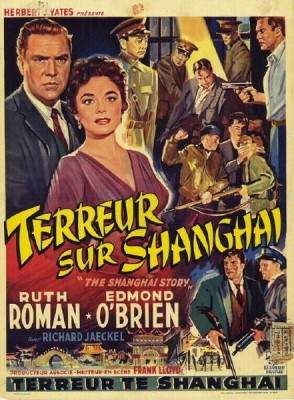| Reviews & Columns |
|
Reviews DVD TV on DVD Blu-ray 4K UHD International DVDs In Theaters Reviews by Studio Video Games Features Collector Series DVDs Easter Egg Database Interviews DVD Talk Radio Feature Articles Columns Anime Talk DVD Savant Horror DVDs The M.O.D. Squad Art House HD Talk Silent DVD
|
DVD Talk Forum |
|
|
| Resources |
|
DVD Price Search Customer Service #'s RCE Info Links |
|
Columns
|
|
|
Shanghai Story, The
Tensely and atmospherically directed by Frank Lloyd (Mutiny on the Bounty, Cavalcade), The Shanghai Story is an atypically upscale film from Republic, though it plays to that B-picture studio's strengths in other respects. The ensemble cast, headlined by Edmond O'Brien and Ruth Roman, is also unusually good.
Further, Olive's Blu-ray of this Paramount-licensed title, in 1.85:1 widescreen and black-and-white, looks great throughout.
With the Communist takeover in China, foreign residents in Shanghai are rounded up and interred at the Waldorf House Hotel. The rules are strict and unforgiving: under house arrest, the foreigners aren't allowed to step outside the hotel for any reason, are subject to searches day and night, and are forbidden to lock the doors to their assigned rooms. Further, Major Ling Wu (Korean-American Philip Ahn) puts the foreigners on starvation rations until they fink on the spy among them who's secretly been sending radio messages to the west.
The Shanghai Story is a veritable catalog of evil Asian foreigners terrorizing vulnerable, innocent westerners. An old missionary with a kind face (Basil Ruysdael) is tortured. A terminally ill Swede (Frank Ferguson) who can barely stand gets the old bamboo-shoots-under-the-fingernails treatment. A Chinese nationalist (Victor Sen Yung) is executed, shot in the back of the head, in the hotel lobby for all to see, including elderly women and the little girl, who later is denied access to a nearby hospital for emergency surgery.
Major Wu openly lusts after the comely wife (Yvette Duguay) of one man, De Verno (Paul Pecerni), further torturing and imprisoning him without cause. Wu slips into her hotel room in the middle of the night while De Verno is being held elsewhere. "You want him back, don't you?" asks Wu and, click, out goes the light.
The primary stars are Edmond O'Brien and Ruth Roman. He plays a world-weary doctor, Dan Maynard; she's Tangiers-born Rita King, a "protected" woman that Colonel Zorek (Marvin Miller), "a stooge for the commies," is romancing. Maynard is concerned that Rita has been planted by the commies to uncover the spy in their midst, but later she convinces the doc otherwise after she agrees to move to Zorek's hotel in exchange for the little girl's medical treatment. The narrative is different, but Roman's character is rather like Ava Gardner's in Nicholas Ray's later 55 Days at Peking (1963). Other characters include war profiteer Ricki "I'm not on anybody's team" Dolemine (Barry Kelley), ex-sailor "Knuckles" Greer (Richard Jaeckel), and painter Paul Grant (Whit Bissell, hoo-ray!). So who's the spy sending vital strategic info back to Tokyo?
How soon they forget. After Pearl Harbor, Life magazine ran a notoriously racist article entitled "How to Tell Japs from the Chinese," pointing out the alleged physiological differences between the two nationalities. Japan, after all, was America's sub-human, morally bankrupt enemy while the Chinese were our noble allies. By 1954, when The Shanghai Story was released, those roles had completely flip-flopped, just as the Germans and Russians had traded places on the other side of the world. That such extreme movie portrayals would so reverse themselves in less than a decade is as fascinating as it is appalling.
Lloyd originally hoped to shoot the film on location in the Far East, but in the end settled for Republic's Studio City backlot. Unlike most Hollywood-created Asian settings, The Shanghai Story's is better than acceptable. It looks nothing like contemporary Shanghai but is impressively, atmospherically photographed by Jack A. Marta, a cinematographer on myriad Republic oaters, Bert I. Gordon monster movies, Route 66 episodes, and even Steven Spielberg's Duel.
Video & Audio
The Shanghai Story, like other Republic-Paramount-Olive titles, looks just great on Blu-ray. In 1.85:1 widescreen, the image has its share of imperfect dissolves, hairline negative scratches and other minor imperfections, but otherwise looks as good or better than it did when it played movie houses 61 years ago. The mono audio, English only with no subtitle options, is likewise fine. No Extra Features.
Parting Thoughts
The Shanghai Story is a minor but delightful discovery full of interesting surprises, a film of historical and sociopolitical interest, and as entertainment quite suspenseful and engaging. Highly Recommended.
Stuart Galbraith IV is the Kyoto-based film historian and publisher-editor of World Cinema Paradise. His credits include film history books, DVD and Blu-ray audio commentaries and special features.
|
| Popular Reviews |
| Sponsored Links |
|
|
| Sponsored Links |
|
|
| Release List | Reviews | Shop | Newsletter | Forum | DVD Giveaways | Blu-Ray | Advertise |
|
Copyright 2024 DVDTalk.com All Rights Reserved. Legal Info, Privacy Policy, Terms of Use,
Manage Preferences,
Your Privacy Choices | |||||||















